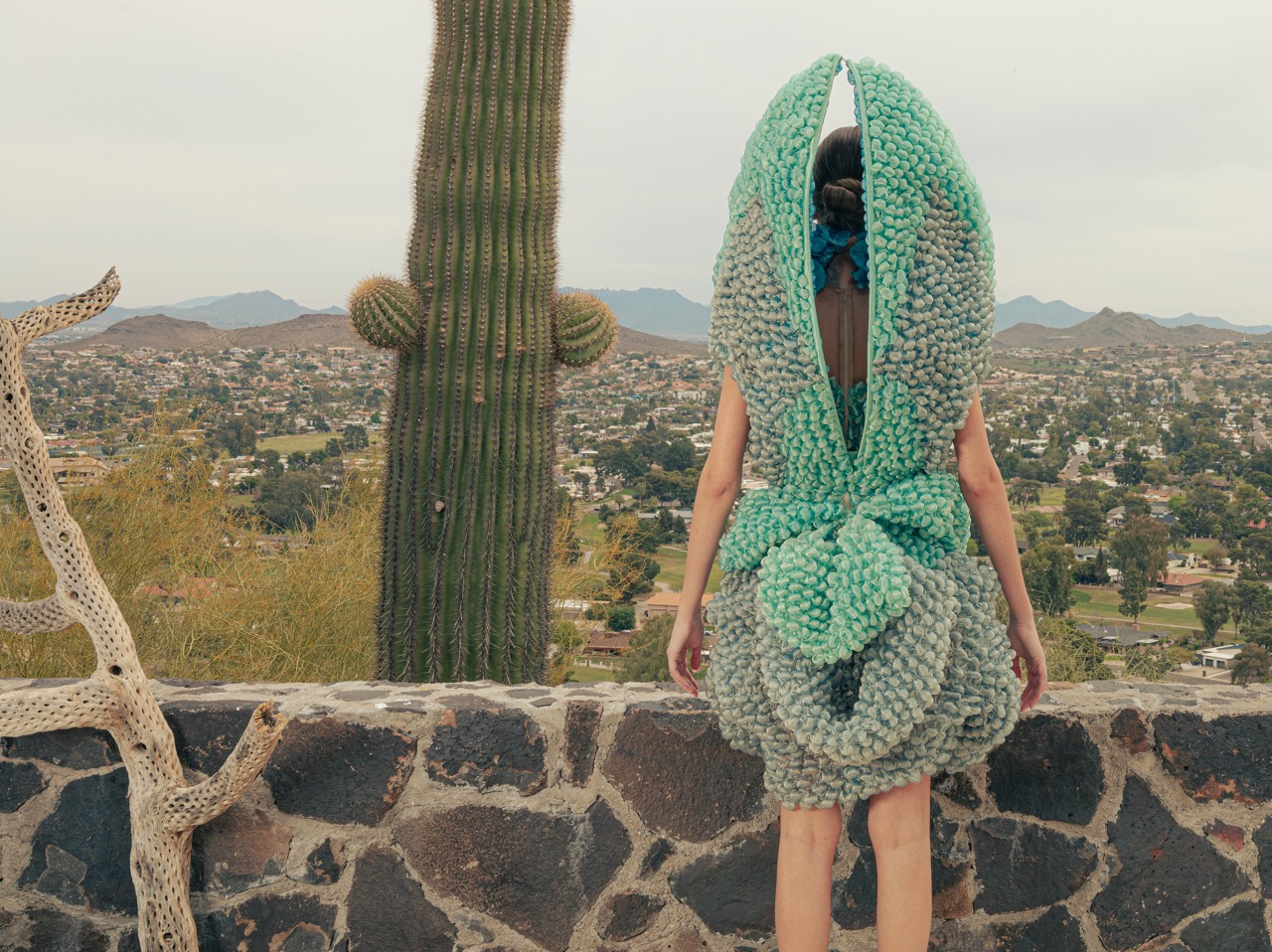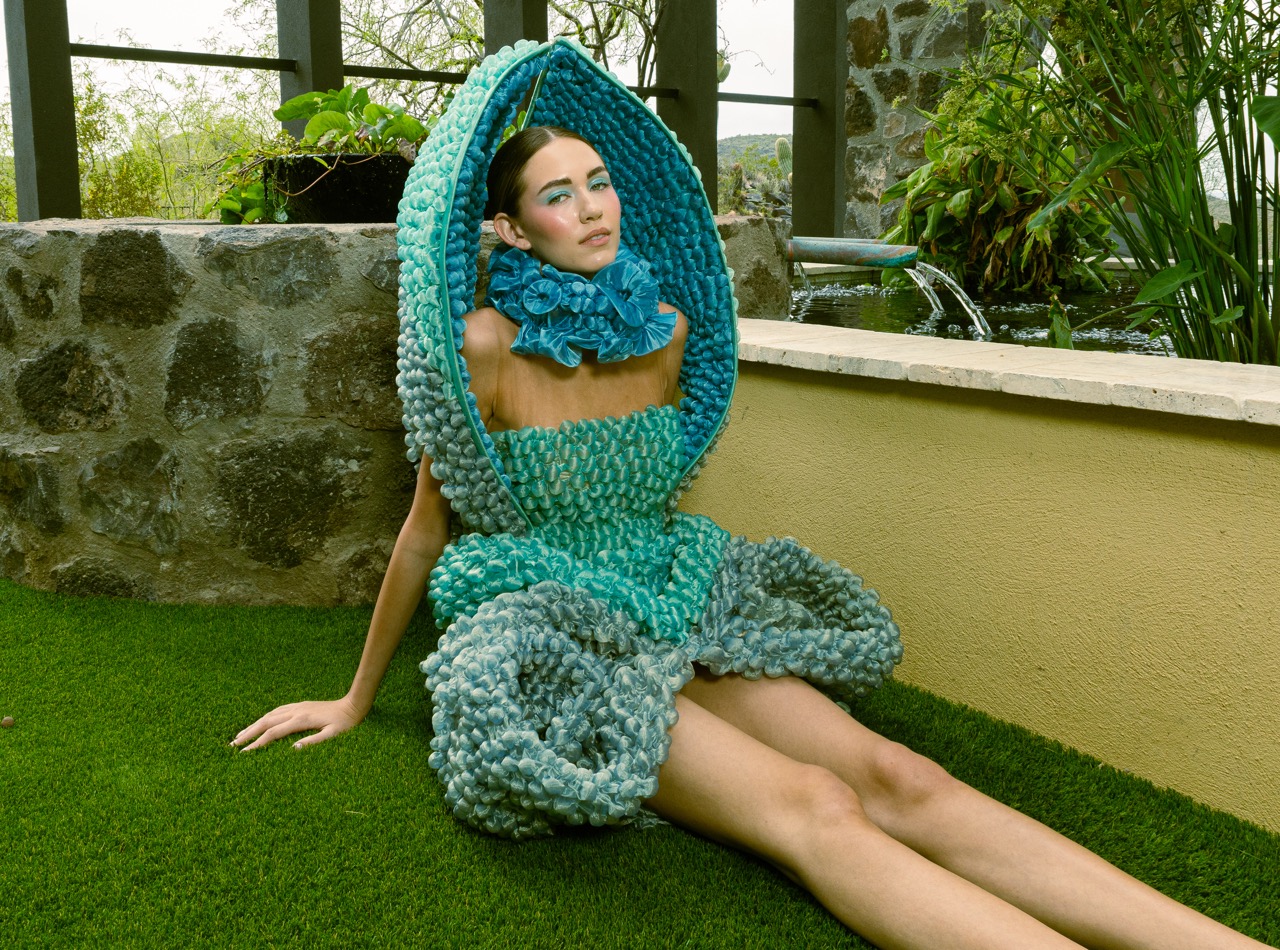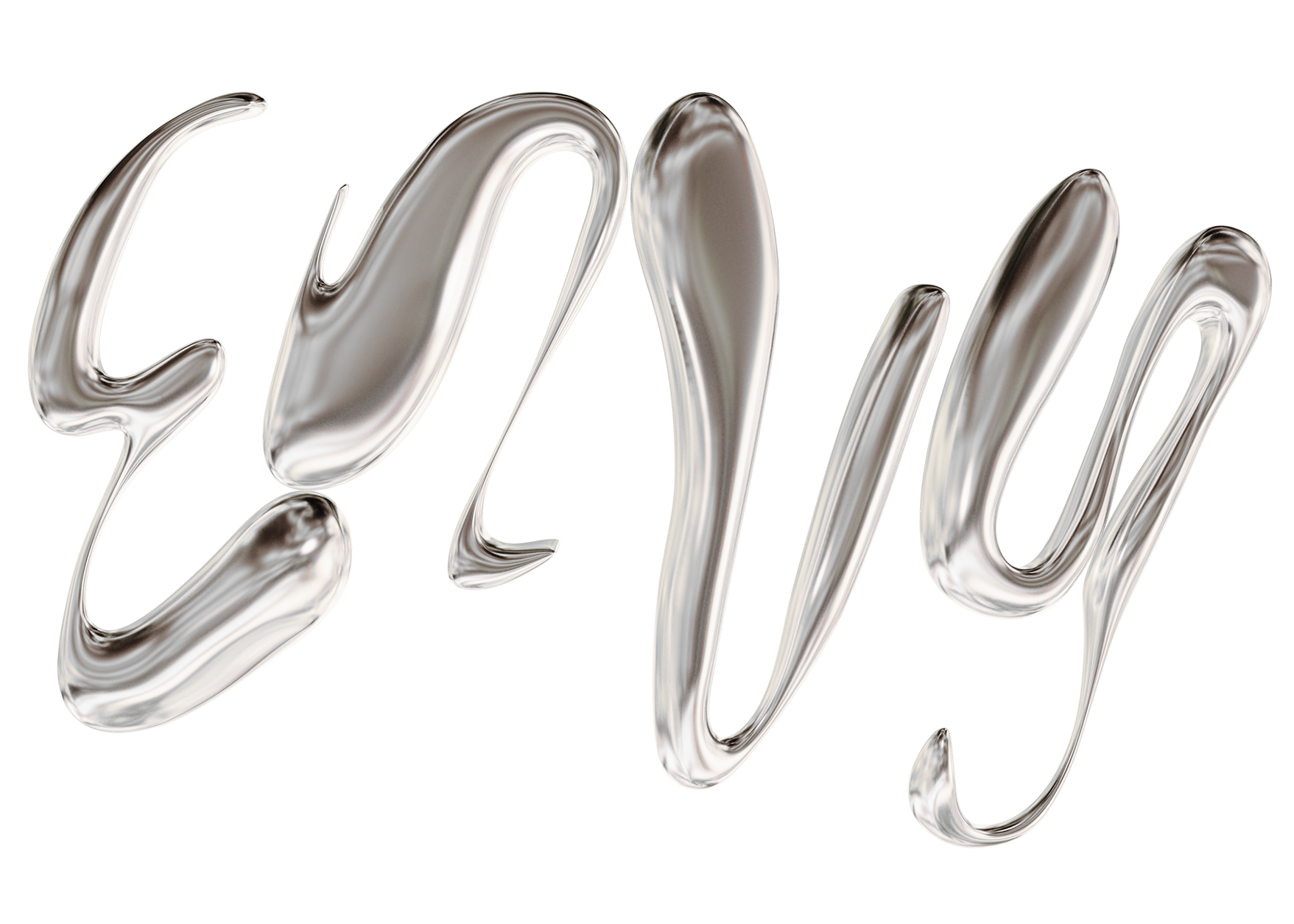BODY - SPACE
ARCHITECTING THE FELLINI COLLECTION WITH GALINA MIHALEVA

CREDITS
Photography
Jilliann Ransom @jillsw0rld
Garments
Galina Mihaleva @galina.mihaleva
Models
Julia Miller @juliamillerrrrr
Kiera Swiger @kiera.swiger
Corrin Schneider @corrinschneider
Space
Casa Luna, home of
Mario Loya and Lee Wood
MUA
Diane Aiello
Production Assistant
Nathan Higdon
Creative Assistant
Lily Moskowitz
Photography
Jilliann Ransom @jillsw0rld
Garments
Galina Mihaleva @galina.mihaleva
Models
Julia Miller @juliamillerrrrr
Kiera Swiger @kiera.swiger
Corrin Schneider @corrinschneider
Space
Casa Luna, home of
Mario Loya and Lee Wood
MUA
Diane Aiello
Production Assistant
Nathan Higdon
Creative Assistant
Lily Moskowitz
“It is like breathing.”
Galina Mihaleva wears a sleeveless beige vest streaked with cream and black textures created with her signature felting technique. A Bulgarian-born fashion designer and a professor of wearable technology at Arizona State University, Mihaleva is a master of the merge: between clothing and environment, art and science, body and performance.
When asked where she finds inspiration for her work, Galina Mihaleva doesn’t skip a beat. Design to her is like breathing- fitting, as her presence feels like a breath of fresh air. Creative spirit springs off of her, as she beams with exuberance and buzzes about in springy curls. That fashion design comes so naturally to Mihaleva speaks to the core of her ideology, which centers around biological-environmental relation, bodily conversation, and biomimetic fabrication. To Mihaleva, fashion is a “mutual dialogue between body and dress” - a principle that blends wearer and garment just as it bridges the gap between nature and technology. There is a theater to the bodies clothed by Mihaleva, their limbs extended into fantastical forms and figures. Her clothing is otherworldly in the way that it often feels as if to have grown from the earth. Silhouettes mimic organic forms and draping syncs with the rhythms of marine life.

This approach to fashion as a kind of earthly interpretation is reinvented in Mihaleva’s recent capsule collection. A blush high-necked dress features tubular tentacle-like extensions gathered at the hip and groin like the waving anemones or octopi. Trailing down the spine and looping around itself in a frothing train of bubbles, the garment appears as if constructed of barnacles or diaphanous pearls. Vertebral, amphibian, this does not seem a dress as much as a living structure growing from the body itself.
The collection in entirety exudes
the same biological feel. Petal-like
ornaments bloom from the neck,

from the hip in lilac bouquets.
Accents of dusted rose gesture
at flora and fauna while hues of
deep wine in other pieces hint at
the mud, the grape. The structures
punctuating this collection resemble
natural life such that a dried crimson
coral blends seamlessly with one
dress’ hue and shape. Its texture
and hue mimic the dress to the point
of cohabitation, as if the fossilized
ornament is a barnacle or accessory
intended to pair with the garment,
or to grow from within. As if the dress
breeds its own organisms. As if
it is an organism of its own.
To Mihaleva, fashion is
a “mutual dialogue
between body and dress”-
her clothing
is otherworldly in the
way that it often feels
as if to have grown
from the earth.
While the Fellini Collection expands upon Mihaleva’s existing design language of textile manipulation and sculptural dimensionality, it was created on request by the Fellini Foundation of Cinema – a cultural incubator that works to promote the film industry and its links to architecture, photography, and design. A working tribute to Italian filmmaker Federico Fellini, the Foundation commissioned Mihaleva to fashion a series of looks inspired by Fellini’s 1972 semi-autobiographical movie Roma. The film pays homage to the city through a playful portrayal of Roman brothels and prostitutes entrenched in the gutters of Catholicism. Most known for its final scene, an ‘ecclesiastical’ fashion show with priests and nuns parading about in bizarre costumes, the film features monks on roller skates in silken robes. Bishops on bicycles. It is this iconic montage that Mihaleva takes as the focal point for the collection.

Galina’s rendition of Fellini’s Roma runway draws upon the whimsical aspects of religious gallantry with surprising subtlety. This is not the kind of religious imagery that we are used to seeing; gaudy crosses, embellishment, and baroque decadence are not the focus.
Instead, Mihaleva extracts design
inspiration from the film’s
representation of devout
extremity and absurdity. The
seduction of the prostitute is translated
into voluptuous silhouettes,
sloping hips,
exaggerated curvature.
Temptation is not provocative
but gestural; an electric aqua
slitted shell-like headpiece
frames the head and shoulders
in a gaping figure bordering
on vaginal, referencing the
eroticism of Fellini’s brothels
without an ounce of garishness
or obscenity.


Mihaleva’s Fellini collection alongside film stills from Federico Fellini’s Roma,1972.
Meanwhile, the nun’s habit, streaming behind the body in their galloping and peculiar jouissance, is re-fabricated into a headpiece of floppy sapphire bunny ears. High collars reference the modesty of clerical uniform yet the rigidity of religious dress is released into charged coils that snake around the neck and bloom from the jaw and shoulders. In Roma, nuns gallop and cavort down the catwalk. It is not the nuns, but their gallop that Mihaleva factors into this collection. She tells me that it is “the feeling, movement, shape” that inspired her from this scene.


Mihaleva’s Fellini collection alongside film stills from Federico Fellini’s Roma,1972.
Her work proves that clothing does not exist apart from the body but instead works alongside or in tandem with its ebbs, flows, and patterns.
Movement is central to Mihaleva’s design language. Many of her prior works have geared towards outfitting dance and performance– “Reflux”, a garment featuring conductive threads, positions fabric as the connective tissue between skin and surroundings, technologically heightening the mobility of the skirting to mimic and echo the postures of its wearer. Other projects of Mihaleva’s link the rhythm of the body to the rhythm of nature itself. “Blue Perception,” a haute couture piece worn by actress Adrienne Wilkinsin, utilizes shape memory alloy technologies to allow the draping of the garment to generate shape in mimicry with ocean waves. Mihaleva’s garments, as she shares with me, act as “tools to perform”-- yet they do not feel like tools but part of the body, one with them. Moving both with them and against them.

Though Mihaleva’s designs have been exhibited in the likes of Singapore’s MAD Museum, New Zealand’s Nelson Museum, and the Textile Museum of Belgium, she assures me that in her work is not intended to be displayed but to be worn. Not for stillness, but for life. Mihaleva’s garments are works of art meant to engage and embody rather than fossilize. Another notable design, titled “Palpitations” expresses the internal movements within the body onto the surface of the body itself. An LED light dress which illuminates in response to a pulse receptor and a brain wave receptor, the garment literally interprets the bodily sensations and mental stimulation of its wearer. Body and the dress communicate with one another. Other works, such as “Scentsory Chameleon Bodysuits” embed biometric technologies into the garment to effectively position clothing as the first respondent for crises of health or safety in its wearer; military garments detect chemical warfare agents in the air, medical apparel inject insulin to the diabetic.
“It is the body that makes the dress.”
Mihaleva calls her work “responsive clothing,” emphasizing that it is the wearer that brings the garment alive. The Fellini collection is no different. Though the garments in this particular capsule collection are not intended for heavy-duty functional operations like some of her previous works, the aesthetic and constructional innovation of the pieces place them in the same realm of body-dress conversation, or “responsive clothing” as the rest of Galina’s oeuvre. While her other pieces read the biology of the body and interpret these internal movements externally upon the skin, the Fellini collection instead reads the body’s integration, relation, and interconnection with the space around it. A lilac dress does not seem to so much as catch the light but converse with it, flickering and winking the sun rays into its own iridescence. Each piece in the collection strikes a banter with the body that wears it. As the models walk, the garments quiver and flounce to their gait in something of lightness, of floating. They pass with a breezy air, effervescent and foamy. The models twirl and the dresses appear to curtsy back.
To achieve this structure, each dress
takes about one full week to sculpt
and stitch, and another two to
produce. The spherical texture
comes from a Japanese fabrication
technique called shibori, in which
each bubble is individually molded
and shaped around a marble and
then heat-set into place. Intimate
and labor intensive, this process
roots the look of the garment
within the manipulation of the
textile itself rather than the stages
of patternmaking or construction.


Mihaleva’s Fellini collection alongside film stills from Federico Fellini’s Roma,1972.
Approaching fashion design from the textile stage is familiar to Galina. Many of her works feature biomaterials and technological miracles of fabrics that can sense movement, body heat, and air quality. A previous project, titled “Breathe” features 3D printed ‘smart fabrics’ designed to alert its wearer of low air quality. The textile itself measures the pollution in the air and changes color to alarm the wearer of danger. Other works by Galina serve similar purposes of detecting and interpreting the state of the environment onto the body itself; a garment called “Sense” mimics the structure of coral with a “polymer and nanocomposite layer” that reacts to environmental pollution through the transformation of discarded plastic polymer products. Her designs fill the gaps between body and surrounding - allowing the clothing, as an extension of the skin, to actually enact biological protections in a way the body could not do on its own. In this way Mihaleva’s fashions provide completion where the body lacks.

Mihaleva often imagines her work in nature, though she is pleased at the way in which her garments converse in other spaces.
Fusing body and environment further informs the visual documentation of Mihaelva’s work. Just as Fellini’s Roma pays homage to place – its narrative revolves around the filmmaker’s move from Rome from his native city Rimini– the photo series capturing the Fellini collection pays particular attention to the site it inhabits.

Phoenix based photographer Jilliann Ransom shoots the Fellini Collection in Casa Luna, the home of Lee Wood and Mario Loya. Nuzzled in the mountains of Central Phoenix, Casa Luna feels akin to a library, a museum, an apiary or a terrarium. It is a kind of space both lively and exhibitionary, one that feels as if to play a character of its own. Each corner of Casa Luna offers an idyllic composition, from the tiled garden and koi pond to the master bedroom, which has been converted for the day into the models’ makeshift green room. There are abstract ceramic vases and sloped metal chairs, oxidized turquoise door frames and hammered silver busts: textured architectures that emphasize sculptural constructions of Mihaleva’s dresses in a striking revelation of the symmetry between body and environment.
Mario Loya, the Creative Director of
Artisan Design, has integrated his interior
design expertise into their home. Lee Wood
confesses that the two would like to live
there until they die: a testament to Casa Luna’s
setting as a kind of memorial, harboring the
artworks both collected and created
![]() over the years of their lives together. Wood
over the years of their lives together. Wood
speaks fondly of their home as an ode to
the land upon which it was erected.
The volcanic
stone constructing their library room was in
fact sourced from the mountain
rock that the house was built upon; external
surroundings have been incorporated into
the innards of the space just as Mihaleva’s
dresses absorb elements of ecological
economies into the organization of fabric and
the postures of the human body. Outside
metabolized within. House as hill. Fashion as flesh.
Artisan Design, has integrated his interior
design expertise into their home. Lee Wood
confesses that the two would like to live
there until they die: a testament to Casa Luna’s
setting as a kind of memorial, harboring the
artworks both collected and created

speaks fondly of their home as an ode to
the land upon which it was erected.
The volcanic
stone constructing their library room was in
fact sourced from the mountain
rock that the house was built upon; external
surroundings have been incorporated into
the innards of the space just as Mihaleva’s
dresses absorb elements of ecological
economies into the organization of fabric and
the postures of the human body. Outside
metabolized within. House as hill. Fashion as flesh.
To heighten the dreamlike quality of Mihaleva’s garments and the fantasy world of Casa Luna, makeup artist Diane Aiello coats the skin of each model in a waxy coating inspired by Pat McGrath’s work at Margiela’s 2024 Artisanal Show. The process is laborious, taking over an hour for each look to fully set. Emerging from the green room, the girls glisten and sheen. Cheeks glassy and pearlescent. Dollike and animated. They glimmer and bloom as if dew on grass, a seawater surface, fixtures of the land.


The intersectionality of Mihaleva’s design ethos finally appears in her role as an educator and instructor. Previously teaching at Nanyang Technological University in Singapore and currently instructing Fashion & Wearable Technology classes at Arizona State University, Mihaleva extends her position as a maker to that of a mentor. Galina beams when I ask her about experience as a professor. Overflowing with gratitude, she joyfully speaks of operating “on the same level” as her students, in which they mutually learn from one another rather than maintaining the typical hierarchy of master and apprentice. Through and through, Mihaleva’s practice is one of harmony and symbiosis: between teacher and student, object and organism, product and artwork, body and space.

